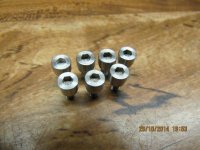Hi Ritchy:
The very small corner radii called for, mean you can't just orbit the electrode and meet spec.
(The corner radii will be the size of the orbit plus the overburn).
This means you have two choices left to try to meet print specs.
One is to go down many times and try to pick out the corners using increasingly large trodes with increasingly fine burns.
The other way is to vector a smaller trode into the corners.
The last post I suggested this strategy on, I got a bit of a pissy response, but it's really a very good strategy, enabling very accurate size control and excellent corner sharpness.
Here's the thread:
http://www.practicalmachinist.com/vb/edm-machining/deep-pocket-erosion-problems-293049/
The burn is not a hex orbit; it goes radially outward into each corner in succession, burning sideways in X and Y rather than down in Z.
If you need a sharp corner between the walls and floor, you can also drop a bit in Z as you move outward in X and Y.
Since the electrode is made a good bit smaller than the cavity, it's also easy to flush.
It's not clear from your description whether you have a hole in your workpiece that will allow you to flush through the hole, or if it's just a rough drilled blind pocket to clear out most of the material before you begin your burn.
I'm assuming the latter: if that's the case you can hit your specs most quickly by making the trode small enough to drop into the hole without touching the sidewalls and then burning out sideways as I've described.
This will keep your corner wear down because the burn is distributed more evenly over the sides of the trode rather than being concentrated on the leading corners as it would be if you made the trode close to full size and burned down in Z only.
More contact surface earlier means you can put more power into the burn without wiping out the corners of the trode, so it's quite a bit faster and gives you a better result too.
Cheers
Marcus
Implant Mechanix – Design & Innovation - home
Vancouver Wire EDM -- Wire EDM Machining
Home

